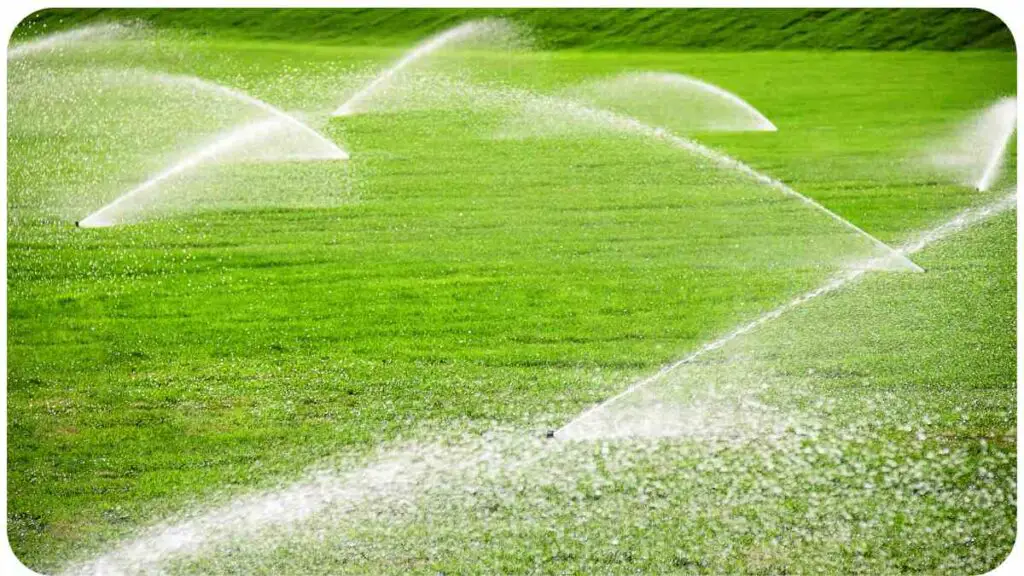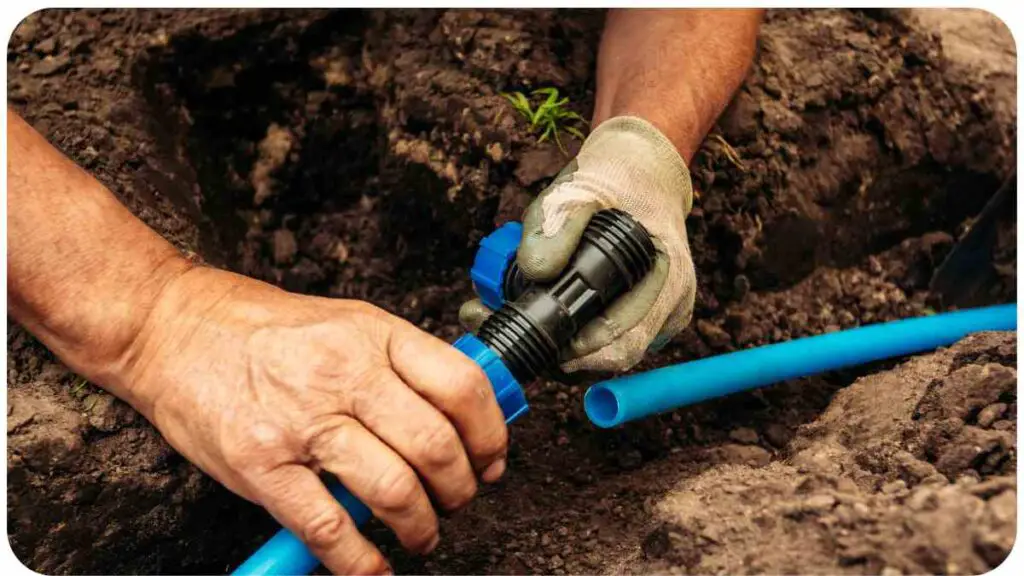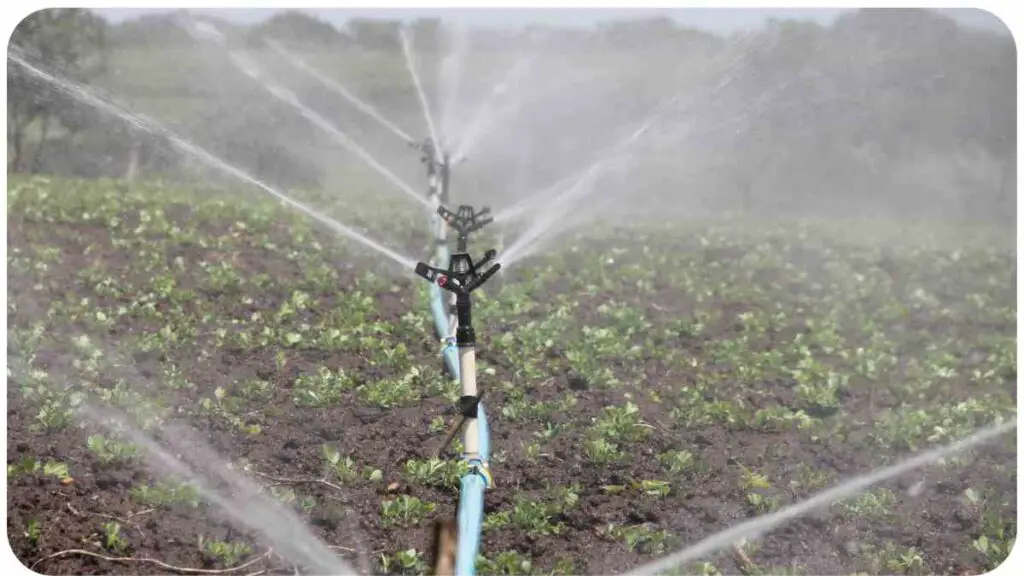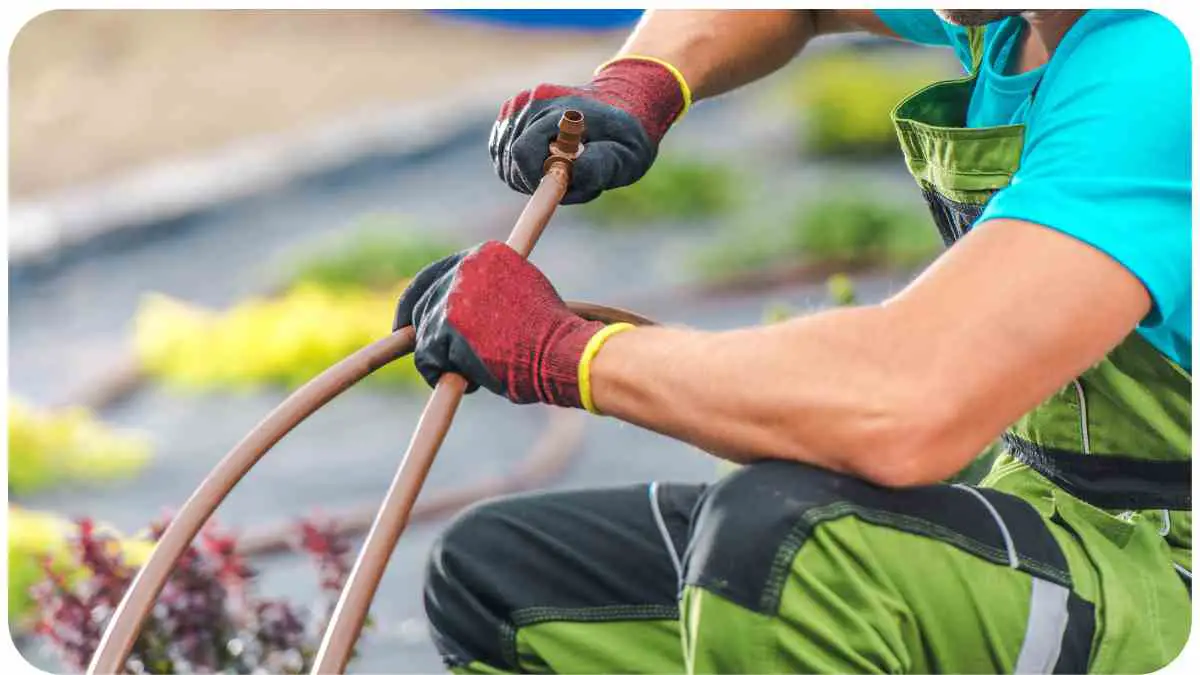Picture a lush, green lawn, vibrant flowers, and thriving shrubs. A well-maintained irrigation system is the backbone of such beauty. However, like any system, irrigation setups can run into hiccups. As someone deeply rooted in the world of irrigation, I’ve encountered and conquered these issues firsthand.
In this guide, we’ll dive into troubleshooting common irrigation system problems, equipping you with the expertise to tackle issues head-on and maintain a flourishing landscape.
| Key Learnings |
|---|
| Understand your irrigation system’s components and functions |
| Diagnose and address common water flow and coverage issues |
| Tackle low water pressure and clogged nozzles effectively |
| Troubleshoot electrical and controller problems |
| Swiftly fix leaks and pipe breaks |
| Adjust sprinkler head positions for optimal performance |
| Implement seasonal adjustments and maintenance practices |
| Navigate drip irrigation-specific challenges with confidence |
| Consider upgrading to smart irrigation technology |
| Know when to seek professional help and when to DIY |
Understanding Your Irrigation System
Before we delve into solutions, let’s grasp the fundamentals. Your irrigation system consists of various components working harmoniously. Sprinklers, pipes, controllers, and nozzles – each plays a crucial role. Understanding how they interact empowers you to troubleshoot effectively.
If your lawn has uneven patches, learn how to fix them with practical steps. Achieve a lush and smooth lawn by addressing uneven areas and promoting healthy growth.
Identifying Water Flow Issues

Water flow problems are akin to a weak heartbeat. Common issues include reduced spray distance and uneven coverage. Take a look at the table below to grasp these issues and their fixes:
Table: Common Water Flow Problems and Solutions
| Problem | Possible Cause | Solution |
| Reduced spray distance | Clogged nozzles, low pressure | Clean nozzles, check for pressure fluctuations |
| Uneven coverage | Obstructed heads, nozzle issues | Clear obstructions, replace faulty nozzles |
Facing uneven watering? Don’t worry, let’s explore the causes and remedies.
Dealing with Uneven Water Distribution
Uneven watering can lead to patchy landscapes and stressed plants. It’s like giving some friends too much attention at a party while others feel neglected. Let’s even things out using the table below:
Experiencing yellow leaves on your plants? Discover a comprehensive solution to this issue. Understand potential causes and take steps to restore vibrant greenery to your garden.
Table: Causes and Fixes for Uneven Watering
| Cause | Solution |
| Misaligned sprinkler heads | Adjust head positions for even coverage |
| Clogged nozzles/emitters | Clean or replace as needed |
| Pressure variations | Install pressure regulators if necessary |
| Uneven terrain | Use rotator nozzles for better distribution |
Imagine your landscape getting the care it deserves, just like friends at a well-balanced gathering.
Addressing Low Water Pressure

Low water pressure feels like trying to run with a slow leak in your shoe. Let’s avoid that discomfort. Dive into the table below to diagnose and remedy low water pressure:
Table: Factors Affecting Water Pressure and How to Fix Them
| Factor | Solution |
| Partially closed valves | Open valves fully for proper pressure |
| Clogs in pipes or filters | Clean filters, inspect and clear clogs |
| Water source issues | Ensure a consistent and adequate water supply |
| Faulty pressure regulators | Replace regulators if they’re not functioning |
Walking with proper water pressure is like having the right shoes on for a comfortable journey.
Tackling Clogged Nozzles and Emitters
Just like a blocked artery can cause health issues, clogged nozzles and emitters can hinder your irrigation system’s well-being. These components ensure even water distribution. Refer to the table below to master the art of prevention and cleaning:
Annoyed by a dripping outdoor faucet? Learn how to repair it with step-by-step guidance. Save water and prevent wastage by fixing this common issue efficiently.
Table: Cleaning and Maintenance Schedule for Nozzles and Emitters
| Task | Frequency | Steps |
| Regular inspection | Monthly | Check for debris, mineral deposits, and clogs |
| Flushing | Every 3-6 months | Remove and clean nozzles/emitters thoroughly |
| Filter maintenance | Annually | Clean or replace filters to prevent clogs |
Clearing clogs ensures your landscape breathes freely, much like a healthy cardiovascular system.
Handling Electrical and Controller Problems
Controllers are the brains behind your irrigation system, and electrical glitches can disrupt their smooth operation. Think of it like a hiccup in your system’s nervous system. Look at the table below to troubleshoot such issues:
Table: Troubleshooting Controller and Electrical Glitches
| Problem | Possible Cause | Solution |
| Controller not working | Power outage, faulty wiring | Check power supply, inspect wiring |
| Incorrect scheduling | Programming errors | Review and reprogram schedule accurately |
| Valve not opening | Solenoid issues | Test solenoid, replace if necessary |
Managing these electrical hiccups is like ensuring your brain communicates smoothly with your body.
Fixing Leaks and Pipe Breaks
A leak or pipe break in your irrigation system is like a plumbing emergency in your home – it needs immediate attention. Follow the guidance in the table below to detect and fix leaks promptly:
Table: Steps to Detect and Repair Irrigation Leaks
| Step | Procedure |
| Visual inspection | Look for damp spots, pooling water, or soggy areas |
| Check water pressure | Abnormal pressure drop could indicate a leak |
| Isolate the leak | Turn off sections individually to pinpoint the leak |
| Repair or replace | Fix or replace damaged pipes, fittings, or joints |
Swiftly addressing leaks ensures your landscape and wallet stay dry.
Adjusting Sprinkler Head Positions
Like a spotlight at a theater, your sprinkler heads need proper positioning for optimal performance. Let’s explore the table below to learn how to adjust them accurately:
Table: Sprinkler Head Adjustment Guide
| Situation | Adjustment |
| Overlapping coverage | Reduce spray distance or adjust angles |
| Dry spots | Increase spray distance or adjust angles |
| Obstructed coverage | Trim vegetation or adjust head height |
| Uneven water distribution | Realign and adjust sprinkler positions |
Adjusting sprinkler heads ensures every plant gets its time in the limelight.
Stay tuned for the continuation of this informative article, where we’ll explore seasonal adjustments, drip irrigation-specific issues, and more.
If you’ve ever wondered how to maintain a lush landscape through the seasons, troubleshoot drip irrigation challenges, and decide when it’s time to call in the pros, you won’t want to miss the next installment. In the meantime, put these strategies into action and watch your garden thrive!
Is your rainwater harvesting system malfunctioning? Discover troubleshooting steps to identify and resolve issues. Ensure optimal rainwater collection and utilization for sustainable garden practices.
Seasonal Adjustments and Maintenance
Just as our wardrobe changes with the seasons, so does the care our landscapes require. Let’s dive into the table below to understand the crucial seasonal adjustments and maintenance tasks:
Table: Seasonal Maintenance Checklist
| Season | Tasks |
| Spring | Inspect and clean nozzles, adjust sprinkler heads |
| Summer | Monitor for dry spots, adjust watering frequency |
| Fall | Rake leaves away from sprinklers, prepare for winter |
| Winter | Drain and winterize the system to prevent freezing |
As seasons change, so should your approach to irrigation system care.
Drip Irrigation-Specific Issues
Drip irrigation offers precision watering, but it also comes with its unique set of challenges. Think of it as a specialized diet for your plants. Refer to the table below for insights on troubleshooting common drip irrigation problems:
Table: Common Drip Irrigation Problems and Solutions
| Problem | Possible Cause | Solution |
| Emitter clogging | Sediment buildup in lines | Flush the system, use filters |
| Uneven flow | Pressure variations, clogs | Install pressure regulators, check for clogs |
| Root intrusion | Nearby plants infiltrating | Use root barriers, inspect and clear lines |
Navigating drip irrigation issues requires precision and understanding, much like caring for delicate plants.
Upgrading Your Irrigation System

As technology evolves, so do irrigation systems. Upgrading can enhance efficiency and water conservation. It’s like getting a new gadget that simplifies your life. Explore smart controllers, weather sensors, and efficient nozzles to take your system to the next level.
Combat pests effectively in your garden with helpful tips and tricks. Safeguard your plants from damage caused by pests and maintain a thriving garden ecosystem.
Professional Help: When to Call an Expert
While DIY is empowering, there are times when a professional touch is invaluable. If you’re facing complex electrical issues, major leaks, or extensive system upgrades, seeking a qualified irrigation technician can save time and prevent costly mistakes.
DIY Tips for Preventing Future Problems
Prevention is the best medicine, even for irrigation systems. Embrace these DIY practices to maintain your system’s health and longevity. Regularly inspect for leaks, clean nozzles and filters, monitor water pressure, and adjust schedules based on weather changes.
Conclusion
Your irrigation system is the lifeline of your landscape, ensuring its vitality and beauty. Armed with the insights and tips shared in this article, you now possess the knowledge to troubleshoot common irrigation system problems like a seasoned pro.
Remember, understanding your system, being proactive, and knowing when to seek expert help are key components of a flourishing garden. So, grab your tools, put on your gardening gloves, and let’s keep those sprinklers dancing and those flowers blooming. Happy irrigating!
Further Reading
For more in-depth information and insights on troubleshooting irrigation system problems, consider exploring the following resources:
The Budd Group: Troubleshooting Problems with Your Irrigation System Short Description: This comprehensive guide provides practical solutions to common irrigation system issues, helping you maintain a healthy landscape.
Lawn and Reticulation: Common Irrigation Issues and How to Fix Them Short Description: Learn from real-world experiences as the author discusses and resolves frequent irrigation problems, giving you hands-on advice.
Living Water Smart: Common Irrigation Issues and How to Fix Them Short Description: Dive into this informative resource to discover effective solutions to irrigation woes, shared by experts in water management.
FAQs
Here are some frequently asked questions about troubleshooting irrigation system problems:
How do I know if my irrigation system has a leak?
Leaks often result in damp spots, pooling water, or soggy areas in your landscape. Conduct regular visual inspections, monitor water pressure, and isolate sections to pinpoint the leak’s location.
What should I do if my sprinkler heads are not providing even coverage?
Uneven coverage can stem from misaligned sprinkler heads, clogged nozzles, or pressure variations. Adjust head positions, clean nozzles, and consider installing pressure regulators for consistent water distribution.
Can I fix clogged nozzles and emitters myself?
Absolutely. Regularly inspect and clean nozzles or emitters to prevent clogs. Flushing them every few months and maintaining filters annually can help maintain proper water flow.
How can I prevent electrical glitches in my irrigation controller?
To prevent electrical issues, ensure proper wiring and power supply to your controller. Regularly review and reprogram the schedule to avoid programming errors that could disrupt your system.
When is the right time to call a professional for irrigation system problems?
Consider seeking professional help for complex electrical issues, major leaks, or system upgrades beyond your expertise. A qualified irrigation technician can save you time and prevent costly mistakes.

Hi! My name is Hellen James, and I’m here to help you with your home-maintenance needs. Whether it’s building a better yard or just trying to fix a garden—I can show you how.


